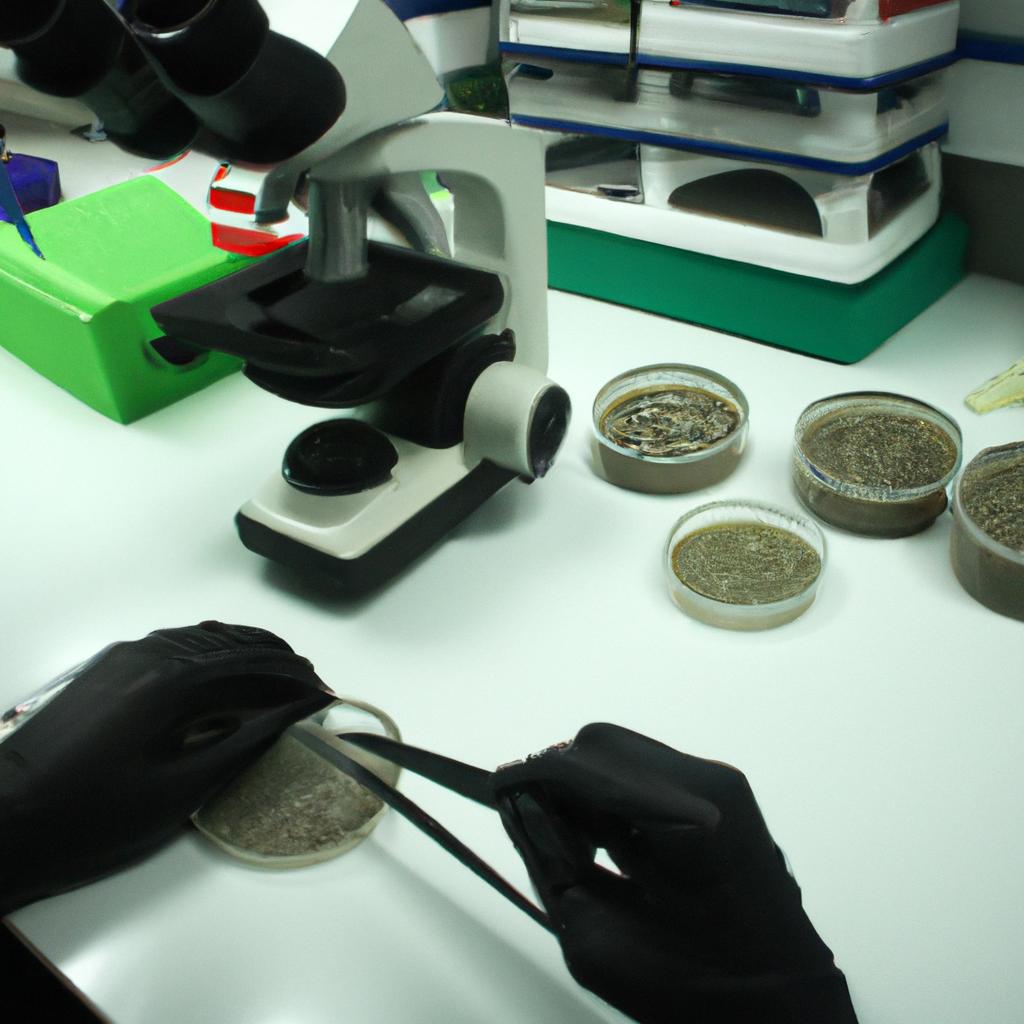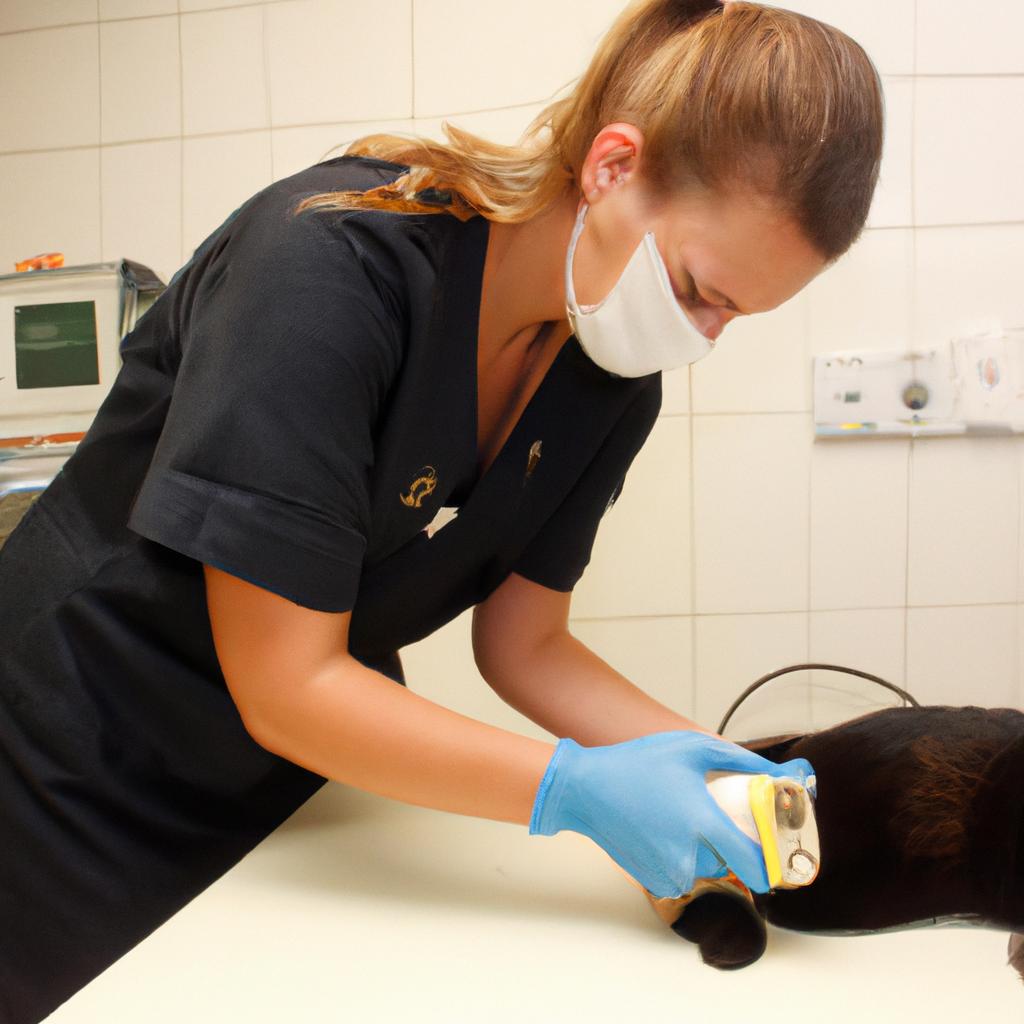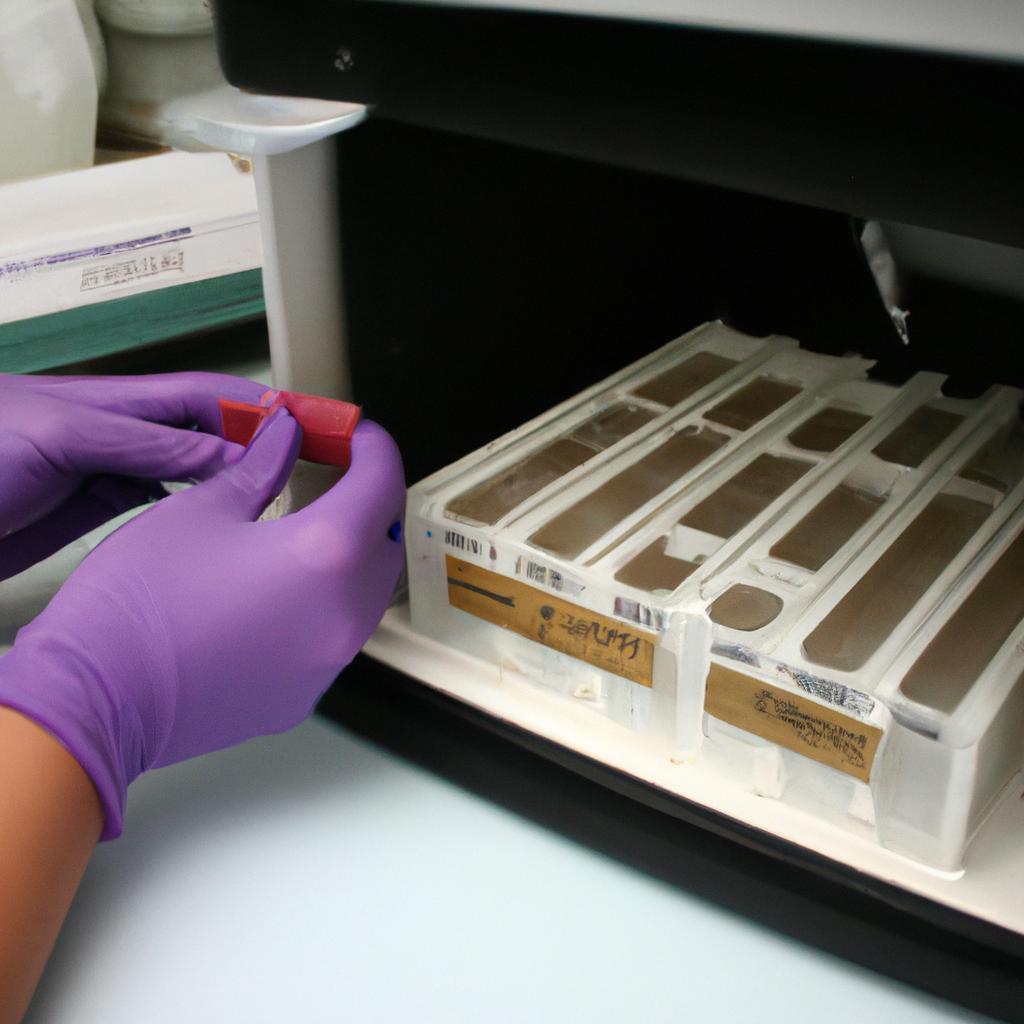In veterinary clinical pathology, the prevention of parasitic infections plays a crucial role in ensuring optimal health and well-being of animals. Parasites can have detrimental effects on host organisms, causing various diseases and impairing overall physiological functions. For instance, consider a hypothetical case study where a dog named Max presents with symptoms such as weight loss, anemia, and gastrointestinal disturbances. Upon diagnostic examination, it is discovered that Max has been infected with intestinal parasites. This example highlights the significance of implementing effective prevention strategies in veterinary clinical pathology to mitigate the occurrence and impact of parasitic infections.
To combat parasitism effectively, veterinarians employ various preventive measures tailored to specific parasite species and individual animal needs. Firstly, regular deworming protocols are recommended for pets susceptible to internal parasites like roundworms, hookworms, whipworms, and tapeworms. These protocols involve administering anthelmintic medications at appropriate intervals to eliminate any existing infection or prevent future infestations. Secondly, maintaining proper hygiene practices is paramount in preventing external parasites such as fleas and ticks from affecting animals’ health. Regular grooming sessions paired with the use of flea and tick control products contribute significantly to reducing the risk of parasitic infestations. Additionally, environmental management techniques Additionally, environmental management techniques are essential for preventing parasitic infections in veterinary clinical pathology. This involves keeping the animal’s living environment clean and free of potential sources of infection. Regular cleaning and disinfection of bedding, cages, and kennels can help eliminate parasites’ eggs or larvae that may be present. It is also crucial to practice proper waste disposal to minimize the risk of contamination by parasite eggs or larvae.
Furthermore, implementing vector control measures is important in preventing the transmission of parasitic diseases. For example, using insecticides or repellents on animals can help deter mosquitoes or flies that transmit heartworm disease or other blood-borne parasites. Additionally, controlling rodents or other intermediate hosts that may serve as reservoirs for certain parasites can reduce the overall risk of infestation.
In addition to these preventive measures, routine veterinary check-ups and screenings are vital for early detection and timely treatment of any potential parasitic infections. Veterinarians may perform fecal examinations to identify intestinal parasites, conduct blood tests for detecting blood-borne parasites, or use diagnostic imaging techniques to detect certain parasitic infections.
Overall, a comprehensive approach combining regular deworming protocols, good hygiene practices, environmental management techniques, vector control measures, and routine screenings is crucial for effective prevention of parasitic infections in veterinary clinical pathology. By implementing these strategies consistently, veterinarians can help ensure optimal health and well-being for animals like Max and prevent the detrimental effects caused by parasitic infestations.
Understanding the life cycle of parasites
Understanding the Life Cycle of Parasites
Case Study: Imagine a dog named Max who presents at a veterinary clinic with symptoms of weight loss, lethargy, and diarrhea. Despite being on regular deworming treatment, Max’s condition continues to worsen over time. This puzzling situation highlights the importance of understanding the life cycle of parasites in veterinary clinical pathology.
Parasites are organisms that rely on other living beings for their survival. They can be found in various parts of an animal’s body, such as the gastrointestinal tract or bloodstream. To effectively prevent and control parasitic infections in animals, it is crucial to comprehend their life cycles—the series of developmental stages they go through from one host to another.
To elucidate this concept further, consider the example below:
- A dog ingests infective eggs or larvae while sniffing contaminated soil during outdoor activities.
- Inside the dog’s gastrointestinal tract, these eggs hatch into larvae that penetrate the intestinal wall.
- Larvae migrate to different organs within the dog’s body via blood vessels or lymphatics.
- Finally, adult parasites develop and start laying eggs in the intestines, continuing the cycle.
Understanding this complex life cycle allows veterinarians to implement effective prevention strategies against parasites. Here is a table summarizing key points about parasite life cycles:
| Stage | Description | Duration |
|---|---|---|
| Egg | The initial stage where parasites exist as microscopic eggs | Varies |
| Larva | The larval stage following egg hatching | Days to weeks |
| Migration | Movement of larvae within an animal’s body | Hours to months |
| Adult | Fully developed parasite capable of reproduction | Weeks to years |
By comprehending these intricate details, veterinary professionals can educate pet owners about specific preventive measures tailored to each stage of a parasite’s life cycle. This approach helps ensure the long-term health and well-being of animals.
Transitioning into the subsequent section on implementing a comprehensive parasite control program, it is evident that understanding the life cycle of parasites lays the foundation for effective preventive strategies. By incorporating this knowledge into practice, veterinary professionals can take proactive measures to combat parasitic infections in animals.
Implementing a comprehensive parasite control program
Understanding the life cycle of parasites is crucial for developing effective prevention strategies in veterinary clinical pathology. By comprehending how parasites reproduce and spread, veterinarians can implement targeted approaches to control their prevalence and mitigate associated health risks. To illustrate this point, consider a hypothetical case study involving a dog named Max.
Max, an otherwise healthy Labrador Retriever, presented with mild gastrointestinal symptoms such as diarrhea and weight loss. After conducting a thorough examination and diagnostic tests, it was determined that Max was infected with roundworms. This scenario highlights the importance of understanding parasite life cycles to identify appropriate preventive measures promptly.
To implement a comprehensive parasite control program in veterinary clinics, several key factors should be considered:
- Regular screening: Routine screening of animals helps detect parasitic infections early on, allowing prompt treatment and preventing further transmission.
- Appropriate use of antiparasitics: The judicious selection and administration of antiparasitic medications are essential to effectively target specific parasites while minimizing the risk of resistance development.
- Environmental hygiene: Maintaining clean living conditions by regularly cleaning kennels or housing areas reduces the likelihood of contamination and subsequent reinfection.
- Client education: Educating pet owners about proper hygiene practices, including regular deworming schedules and disposal of feces in designated areas, promotes responsible pet ownership and minimizes environmental contamination.
Table: Common Parasites in Veterinary Clinical Pathology
| Parasite | Host Species | Transmission Route |
|---|---|---|
| Roundworms | Dogs, cats | Ingestion of eggs from contaminated soil |
| Fleas | Dogs, cats | Direct contact or exposure to infested environments |
| Ticks | Various mammals | Attachment during blood feeding |
| Heartworm | Dogs | Mosquito bite transmitting infective larvae |
Implementing these strategies not only improves individual animal health but also contributes to public health by reducing zoonotic disease risks. By taking proactive measures to prevent parasitic infections, veterinary clinics play a vital role in safeguarding both animal and human well-being.
Regularly screening animals for parasites is an essential step in maintaining their health and preventing the spread of diseases.
Regularly screening animals for parasites
Transitioning from the previous section on implementing a comprehensive parasite control program, it is essential to regularly screen animals for parasites. By conducting routine screenings, veterinarians can identify and treat parasitic infections in their early stages, preventing further health complications and reducing transmission risks.
For instance, consider a hypothetical case where a dog named Max presents with symptoms such as weight loss, diarrhea, and lethargy. Upon screening, it is discovered that Max has been infected with intestinal parasites. Prompt treatment allows for effective management of the infection before it progresses to more severe conditions like anemia or organ damage. This example highlights the significance of regular screenings in maintaining the overall well-being of animals.
To ensure successful implementation of regular screenings for parasites, veterinary clinics should adhere to specific strategies:
- Establish standardized protocols: Developing clear guidelines and protocols for parasite screenings ensures consistency across different cases and allows for accurate interpretation of results.
- Utilize diagnostic tools: Employing advanced diagnostic techniques such as fecal examinations or blood tests enhances the accuracy of parasite detection, enabling timely intervention.
- Maintain comprehensive records: Keeping detailed records helps track individual animal histories and monitor response to treatments over time.
- Educate staff members: Providing adequate training to veterinary personnel regarding various aspects of parasite identification and prevention equips them with the necessary skills to conduct thorough screenings.
In addition to these strategies, creating awareness among pet owners about the importance of regular parasite screenings is crucial. The following table illustrates some key benefits of routine screenings both for pets’ health and public safety:
| Benefits | Description |
|---|---|
| Early detection | Identifying parasitic infections at an early stage facilitates prompt treatment interventions. |
| Preventive measures | Regular screenings allow for proactive preventive measures against potential health risks. |
| Public health safety | Ensuring that pets are free from zoonotic parasites reduces the risk of human infections. |
| Improved quality of life | Detecting and treating parasites early on helps improve pets’ overall health and well-being. |
By actively promoting the benefits mentioned above, veterinarians can encourage pet owners to prioritize regular screenings for their animals. This educational approach empowers pet owners to take responsibility for their pets’ parasite prevention, fostering a collaborative effort between veterinary professionals and animal caregivers.
Building upon the importance of regular screenings, the subsequent section will delve into educating pet owners about effective strategies for preventing parasitic infections in their furry companions.
Educating pet owners about parasite prevention
Building on the importance of regularly screening animals for parasites, another crucial aspect in preventing parasitic infections is educating pet owners about parasite prevention. By providing pet owners with knowledge and understanding, they can take proactive measures to ensure their pets remain healthy and free from parasites.
Case Study:
To illustrate the significance of education in parasite prevention, let us consider a hypothetical case involving a dog named Max. Max’s owner was unaware of the risks associated with internal parasites and neglected regular screenings or preventative measures. As a result, Max contracted a severe case of hookworms that caused him discomfort and compromised his overall health. This unfortunate situation could have been avoided through proper education and awareness.
Educating pet owners about parasite prevention involves imparting essential information regarding various aspects related to effective preventive strategies. Here are some key points that should be covered:
- The life cycle of common parasites: Educating pet owners about the life cycles of different parasites helps them understand how infections occur and spread.
- Identification of signs and symptoms: Teaching pet owners to recognize early signs and symptoms of parasitic infections enables prompt detection and treatment.
- Recommended preventive measures: Providing clear guidelines on preventive options such as regular deworming schedules, appropriate flea control methods, and tick preventatives.
- Environmental management practices: Emphasizing the importance of maintaining clean living environments for pets by practicing good hygiene habits like cleaning bedding regularly.
Table – Emotional Response Evoking Information
| Parasite Prevention Tips | |
|---|---|
| Regular veterinary check-ups | Ensures timely detection |
| Proper disposal of feces | Reduces contamination |
| Administering prescribed preventives | Efficacious protection |
| Avoidance of high-risk areas | Minimizes exposure |
By empowering pet owners with this knowledge, we can evoke an emotional response that emphasizes the responsibility they hold in safeguarding their pets’ well-being. Preventing parasitic infections is a shared effort, and education plays a vital role in creating awareness and promoting proactive measures.
Moving forward, the next section will discuss another important aspect of parasite prevention – practicing proper hygiene and sanitation. By implementing hygienic practices, pet owners can further minimize the risk of their pets contracting parasites.
Practicing proper hygiene and sanitation
Building upon the importance of educating pet owners about parasite prevention, it is equally vital for veterinary professionals to practice proper hygiene and sanitation within their clinical settings. By implementing rigorous protocols and maintaining a clean environment, veterinarians can effectively minimize the risk of parasitic infections in animals under their care.
Paragraph 1:
To illustrate the significance of practicing proper hygiene and sanitation, let us consider a hypothetical scenario where a veterinary clinic neglects these measures. In this situation, imagine that several dogs are brought into the clinic for routine check-ups. Unfortunately, one of these dogs is infected with intestinal parasites such as roundworms or hookworms. Without strict adherence to cleanliness practices, there is an increased likelihood of cross-contamination between infected and non-infected individuals within the facility. This not only puts other pets at risk but also poses potential health hazards to staff members who handle contaminated materials.
Paragraph 2:
To mitigate these risks, here are some key strategies that veterinary clinics should adopt:
- Regular cleaning and disinfection: Ensuring thorough cleaning of all surfaces using appropriate detergents and disinfectants helps eliminate any infectious agents that may be present.
- Proper waste management: Disposing of animal waste promptly and securely prevents contamination and reduces the chances of transmission.
- Frequent handwashing: Veterinary staff must diligently follow hand hygiene practices before and after handling animals or coming into contact with potentially contaminated materials.
- Adequate personal protective equipment (PPE): Wearing gloves, masks, gowns, or other necessary PPE provides an additional layer of protection against possible exposure.
| Strategies for Hygiene & Sanitation |
|---|
| Regular cleaning and disinfection |
| Proper waste management |
| Frequent handwashing |
| Adequate use of personal protective equipment |
By adopting these practices consistently, veterinary clinics create safer environments that help protect both animals and humans from parasitic infections.
Paragraph 3:
Maintaining proper hygiene and sanitation protocols in veterinary clinical settings is an essential aspect of preventing parasitic diseases. These measures not only safeguard the health and well-being of animals but also promote a safer working environment for veterinary professionals. In the subsequent section, we will delve into the importance of collaborating with other veterinary professionals to enhance prevention strategies.
With a strong foundation established through education, hygiene practices, and sanitation efforts, collaborative partnerships among veterinary professionals are crucial for effective prevention against parasites within animal populations.
Collaborating with other veterinary professionals for effective prevention
Building upon the foundation of proper hygiene and sanitation practices, collaboration with other veterinary professionals is essential for effective prevention of parasitic diseases in veterinary clinical pathology. By working together, veterinarians can pool their knowledge and resources to develop comprehensive strategies aimed at safeguarding animal health.
To illustrate the importance of collaboration, consider a hypothetical scenario where a group of veterinary clinics in a particular region notice an increase in cases of tick-borne diseases among dogs. Realizing that this issue requires collective action, these clinics decide to collaborate by forming a regional task force dedicated to combating tick infestations and associated diseases. This collaborative effort allows them to combine their expertise, share data on disease prevalence, and coordinate preventive measures such as implementing vaccination programs or conducting regular screenings for ticks.
Collaboration between veterinary professionals not only facilitates information sharing but also enables the development and dissemination of educational materials targeting pet owners. By pooling resources, these professionals can create informative brochures or online resources emphasizing the importance of preventive measures against parasites. Such materials may include engaging visuals highlighting common parasite species found in the area along with their potential harm to animals. Additionally, they could provide guidance on appropriate preventative medications and techniques for checking pets for signs of infestation.
A key aspect of successful collaboration lies in establishing partnerships with relevant stakeholders outside the direct realm of veterinary medicine. For instance, collaborating with local public health departments can help raise awareness about zoonotic aspects of certain parasitic infections and promote coordinated efforts towards controlling those diseases both in animals and humans. Furthermore, partnering with pharmaceutical companies can facilitate access to affordable parasite control products or even support research initiatives focused on developing new treatment options.
In summary, collaboration amongst veterinary professionals plays a vital role in preventing parasitic diseases within the field of clinical pathology. Through shared knowledge, joint initiatives like regional task forces, creation of educational materials, and engagement with external stakeholders, veterinarians can maximize their impact in safeguarding animal health and reducing the burden of parasitic infections on both pets and humans.
- Increased awareness about parasite-related diseases
- Enhanced access to information and resources
- Improved coordination of preventive measures
- Strengthened advocacy for comprehensive parasite control
| Collaboration Benefits | Description |
|---|---|
| Collective expertise | Veterinarians can combine their knowledge and experience to develop effective prevention strategies. |
| Resource sharing | Collaborative efforts allow for pooling of resources, such as data, education materials, and funding. |
| Coordinated action | Joint initiatives ensure consistent implementation of preventive measures across multiple clinics. |
| Multi-stakeholder involvement | Collaboration with external partners widens the scope of influence and increases support networks. |
By embracing collaboration, veterinary professionals can leverage each other’s strengths to address the challenges posed by parasites effectively. With increased awareness, coordinated actions, resource sharing, and engagement from diverse stakeholders, a more holistic approach towards preventing parasitic diseases in veterinary clinical pathology can be achieved without duplicating efforts or unnecessarily straining limited resources.
 Vet Clin Path Journal
Vet Clin Path Journal



